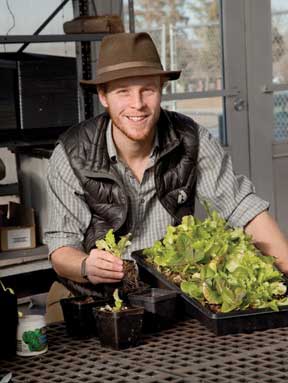10 Great Containers
19 Mar 2014
Think outside the pot when it comes to planting flower displays. Anything from hats and drawers to colanders and pails can become a container.
Here are 10 “pots” to consider.
By Mary Leigh Howell photos courtesy www.digdropdone.com
This growing season, swap out pedestrian flowerpots for more fanciful fare. Flowers don’t care about their container, as long as they have water, drainage and proper light.
“Anything from birdhouses to rain boots to discarded dresser drawers can play host to flowering bulbs,” says Amy Dube, flower bulb expert for www.digdropdone.com. And there’s no need to purchase something new. Shop your garage, attic and garden shed for potential items.
Summer-flowering bulbs like dwarf lilies, calla lilies and dahlias fare well in container gardens and prefer full sun. Dahlias are typically thought of as taller flowers, but for container gardening, low-growing series dahlias like Gallery, Melody and Karma are best. Begonias, caladiums, elephant ears and pineapple lily are also good container-plant choices, but prefer partial shade.
Tall or straight flowers will look best in the middle; ones that cascade are better near the perimeter. When combining different plants in one container, select those with similar bloom times for the greatest visual impact.
Create a balanced look by using complementary colors like yellow and purple. Adding annuals with your favorite summer-flowering bulbs will create a full container and provide instant color.
Here are 10 containers to consider for spring. Happy potting!
1. Recycled Jug ‘Lemon Pixie’ daylilies happily grow in a recycled plastic jug. Saw or cut off the jug’s top and drill a hole in the bottom before planting. ‘Lemon Pixie’ is a dwarf Asiatic hybrid that reaches 12 to 18 inches in height.
2. Straw Hat ‘Candy Prince’ tulips bordered by anemone windflowers are a delightful spring surprise to pull out of a hat. Use a plastic plant liner with a drainage hole to keep in moisture and protect the hat, which will also need a drainage hole to prevent water from rotting the fibers.
3. Teepee A tripod of posts suspends this hanging basket in a meadow. This is a perfect container for a very sunny area. Dwarf pineapple lilies stand tall in the center, and trailing annuals spill over the side. Pineapple lily nectar is especially attractive to bees.
4. Rain boots Spring-flowering bulbs, including daffodils, tulips and hyacinths, sprout from these colorful rain boots. Make sure to drill a hole in the bottom of the boots. Otherwise, bulbs will become waterlogged and rot. No liner is necessary.
 5. Straw purse
Two colors of calla lilies share this “tote-able” container. Place a plastic planting liner in the bottom of the tote, but make sure it and the tote have drainage holes. When planting calla lilies, the “eyes” or growing points should face upward. Callas do better if they don’t get hot midday sun.
5. Straw purse
Two colors of calla lilies share this “tote-able” container. Place a plastic planting liner in the bottom of the tote, but make sure it and the tote have drainage holes. When planting calla lilies, the “eyes” or growing points should face upward. Callas do better if they don’t get hot midday sun.
6. Pails This cluster of sand pails (be sure to drill drainage holes) is filled with low-growing pink and white dwarf gladioluses. Unlike their full-sized cousins, dwarf gladioluses only reach 16 to 32 inches tall and don’t require staking. They like full sun and plenty of water. If deer or other pests roam your patio, fear not: Gladioluses are critter-resistant.
7. Drawers Shallow file drawers are a fine option for begonias, which prefer to be planted right beneath the soil surface. Use a power drill to create several drainage holes in the drawer bottoms. No liner is necessary.
8. China Bowls These spring-flowering iris, hyacinth and muscari bulbs were forced to bloom indoors in winter. When forcing bulbs indoors, use containers without a drainage hole. When planting any forced bulb, it’s best to cover the bulb with soil up to its “shoulders” but leave the “nose” exposed. Keep the soil moist but not wet. And don’t fill the bowls full with soil. Leave room for watering, so the pot won’t overflow.
 9. Birdhouse
This birdhouse pulls double duty and is a unique way to repurpose an existing item in the garden. A “roof” of flowering bulbs provides cover for the feeding area below. Using moss as “mulch” is a colorful touch, and it also retains moisture. This house will need plenty of water as it’s in direct sunlight all day.
9. Birdhouse
This birdhouse pulls double duty and is a unique way to repurpose an existing item in the garden. A “roof” of flowering bulbs provides cover for the feeding area below. Using moss as “mulch” is a colorful touch, and it also retains moisture. This house will need plenty of water as it’s in direct sunlight all day.
10. Colander ‘White Splendor’ windflowers trail from the sides of this enamel colander. Colander holes provide great drainage, but also more air exposure, so line it with a coco liner to keep plants moist.













